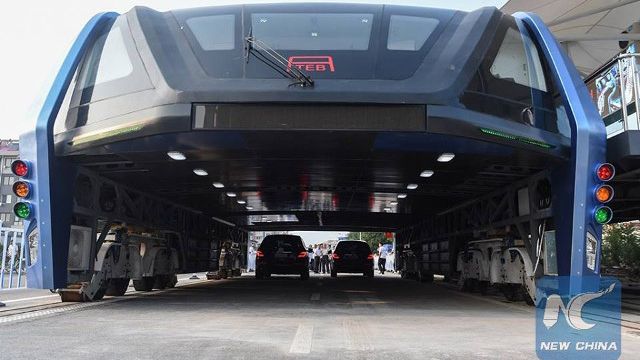Note: Image above courtesy of Shanghaiist
If you have Facebook or any other social media platform, you’ve probably seen video renderings of the traffic straddling bus that’s supposed to cure traffic woes all over the world. It was a novel idea, and like many ideas of that ilk, it was subject to a lot of debate. A lot of people loved it. A lot of people hated it. And that was when the straddling bus was nothing more but a rendering. If by some miracle it actually ended up becoming the real thing, imagine what kind of debate it would create. Well, let the words fly now because China has actually built a working prototype of the traffic straddling bus. More incredibly, it’s about to go on a real-life test run.
To be fair, the traffic straddling bus isn’t just an idea that was thought of one day and created the next. The proposal has actually been on the table for years but it wasn’t until May 2016 when an actual mini model - yes, that happened too - was unveiled at the 19th China Beijing International High-Tech Expo and computer-generated renderings of the bus hit social media. Since then, the video has been shared viewed and shared millions of times with some people lauding the ingenuity behind it while others openly mocked the idea as a too much of a “Jetsons kind of thing.”
The reactions surrounding the proposal didn’t deter the developers of the bus, who, somewhat shockingly, only took a few months to actually create the first prototype of the Transit Elevated Bus (TEB), as it will come to be known from now one. That test run will take place in Qinhuangdao, Hebei province, about 186 miles southwest of Beijing. Since the TEB is still a long ways away from becoming fully functional, the initial run will only feature one bus carriage running on a controlled track measuring just 300 meters in length. It’s not much, but it’s a start.
Once it becomes fully operation - if it ever reaches that point - one TEB can will be able to carry as many as 1,200 passengers at a time and travel at speeds of about 37 miles per hour. More importantly, it would prove to be a far cheaper solution than building subways or train platforms. It still sounds a little silly thinking about it, but the TEB has made it this far to remain skeptical about its potential. All that’s left for the developers is to make sure that it lives up to that potential.
Continue after the jump to read the full story.
Why it matters
A part of me still thinks that this project is too good to be true. That part also expects the roof to fall in at some point. I know it’s not a supportive tone, but I still need to be convinced of the merits of the TEB once it goes past its initial testing.
That said, I’m more than willing to be proven wrong about this. Trust me, I come from a place where traffic costs our local economy loses millions of dollars every year in working hours lost on the road. That’s a fact. If there’s a way to finally curb the congestion problem on the road, I’m all for it. There are other benefits here too, not the least of which is the money it could potentially save compared to building subways and train platforms. It’s also supposed to be quick to build so that’s another positive thing about this proposal.
Clearly, there are plenty of good things about the TEB that could also save a lot of today’s traffic woes. If it turns out that way, we might as well be looking at the miracle cure for public transit. That’s a huge deal, not just for China, but for the entire world. The optimist in me hopes to see that happen one day. I mean, who wouldn’t want to live in a city where traffic becomes minimal or, dare I say, non-existent.
But there’s also the pragmatist in me that’s holding me back from becoming too excited about the possibilities. I don’t want to get too excited and then end up being disappointed if the program doesn’t live up to its potential or is actually a lot more expensive than previously thought. It’s a balance that people need to be wary of lest they fall under the trap of expecting too much from something that’s still largely unproven.
Hopefully, the TEB succeeds in what it intends to do. That’s my hope, just like everybody else who wishes to have a public transportation system that’s cheap, easy, and very comfortable to use.

